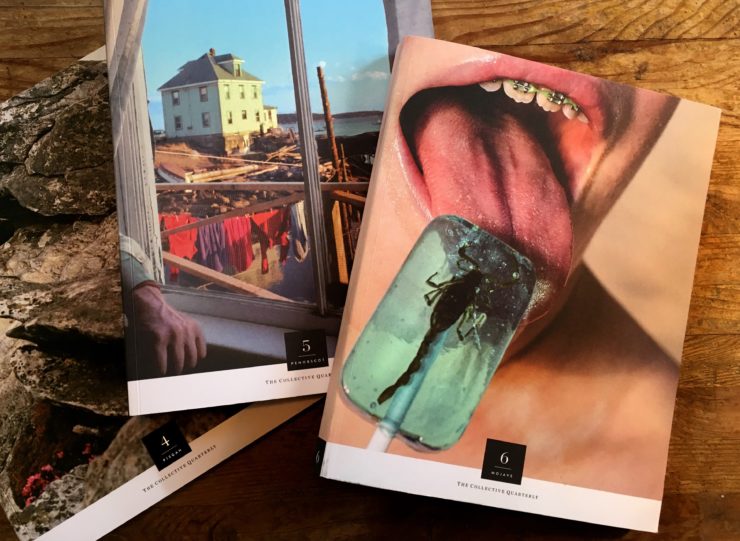In today’s world of impossibly speeded-up journalism, with Twitter bursts its high-velocity symbol, a small group of renegades has resolutely slammed on the brakes to practice what it calls “slow journalism.”
Jesse Lenz and Seth Putnam, who met on the not-exactly-slow site Instagram four years ago, joined the club when they launched the magazine Collective Quarterly soon after. Their aim is to create an outlet for journalists who are willing to take their time and, as Lenz says, “show genuine interest in another human being.”
"Anyone can photograph a sunset in a national park, sexy models or friends in a hot spring. But not everyone can photograph the soul of a stranger."
Each Quarterly is a 200-page collection of dispatches from one geographic region that take the reader behind even the most tightly locked doors in places way off the radar of now-now-now journalism. Volume 4 – “Pisgah” – buskers, wild food eaters, communes and more in N. Carolina’s Pisgah National Forest. Volume 5 – “Penobscot” – sea bugs, life and death on the edge of Maine. Volume 5 – “Mojave” – cadaver holes, moonshiners, freedom and looking for normal in California’s edge-of-infinite desert.
The Collective is composed of freelance journalists from around the country assigned “the difficult task of embedding with a subject so that he or she can capture those intimate moments,” Lenz says.
Lenz tends to assign photographers who shoot film instead of digital images. He says film can determine “how photographers act on location.”
As a photojournalist who matured with 35mm film cameras in the last century, I know exactly what Lenz means. With just 36 frames per roll of film I took it real slow -- to find the rhythm of a scene, to anticipate the decisive moment -- before I squeezed off a shot. A digital “roll of film” with 900 or more frames available can be a temptation to blast away at 10 frames a second.
Documentary journalism and publishing on paper is expensive – especially when it’s the soft, waxy kind that Collective Quarterly uses -- and it’s fading fast. We all know the newspaper and magazine industry is crossing a wobbly bridge from ink to the promised land of digital.
Nevertheless, Lenz talks a mile a minute against digital publication. “There’s tons of free information out there [on the Internet], but it’s crap! With 20 bucks and an iPhone, anybody can be a photographer on Instagram. Quality publication is like a good, modern automobile. Cars today cost a lot because they’re so well-designed and made. And they last like never before. Same with print: It must be super good to sell.”
His passion for the printed magazine notwithstanding, if you go to www.collectivequarterly.com/, you’ll find a gorgeous website.
But it’s like foreplay. There are four or five tempting layouts flickering before your eyes. If you want to go all the way and enjoy the other 15 or so pieces, you’ll have to subscribe.
I chatted with Lenz about the Mojave edition. Here’s what he had to say about “slow journalism” and hunkering down in weird places. The answers have been slightly edited for length and flow. For the images, I decided to photograph the spreads as they appeared in the magazine.
Let’s start with the cover photo of Issue #6, “Mojave.” (See image at top of post.) You have a portrait of a shirtless adolescent licking a lollipop -- with a scorpion imbedded in the transparent blue-green candy! The photo reveals the texture of the boy’s teeth lashed together with green braces, his peach-fuzz mustache and the out-of-this-world topography of his shiny, wet tongue. Tell us about the photo, Jesse; and where on God’s green earth did you find this deadly sucker?
We saw those suckers all over the place when were we caravanning through the Mojave Desert. To me, those suckers are the perfect analogy to what the desert is: candy-coated-death. I remember when my family and I came crashing into the Mojave after wintering in Montana and Idaho in our Airstream, we thought the desert was paradise. It was warm, there were incredible sunsets, and it served as a giant sandbox for our children and dog to play in. But the longer we stayed, we had an increasing level of anxiety that we had never encountered before. So when I was working on the cover, I didn’t want to make the typical “LA” interpretation of the desert: a hippie paradise where everything is beautiful and spiritual.
"I didn’t want to make the typical 'LA' interpretation of the desert: a hippie paradise where everything is beautiful and spiritual."
We’re a pretty different publication than most, since we don’t ever do special cover shoots or plan our covers in advance. I was working through multiple different versions without any real luck or inspiration—nothing was fitting what I knew needed to be the cover. One day, a good friend of mine, Eugénie Frerichs, director of photography at Patagonia, shot me a text to let me know she was just releasing some work she had been creating for her master’s degree before accepting the job at Patagonia. I clicked into her project, which was all about the Mojave, saw this image, and knew it was the one. She laughed so hard, since it was a photo of her nephew.
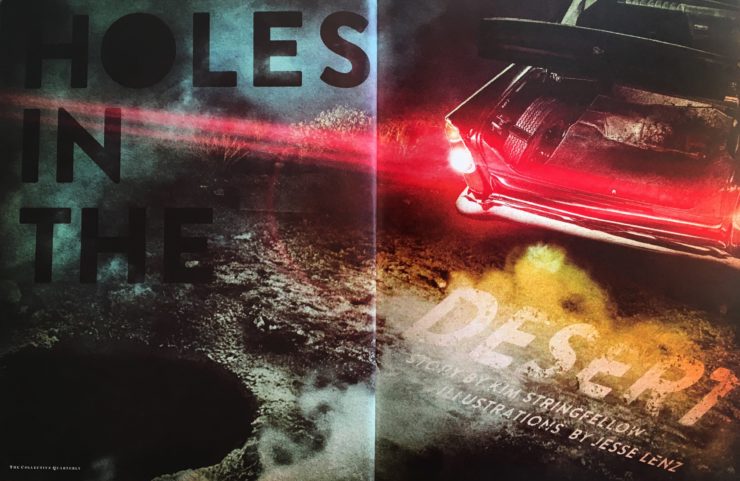
Speaking of “deadly,” the very first story in Mojave is titled “Holes in the Desert.” Your title page photo hints that these holes aren’t golf targets, tortoise burrows or meteor craters but a place to clean out your trunk. Reporter Kim Stringfellow describes California’s vast Mojave region as “…an isolated out-of-the-way destination to conduct a variety of illicit activities…” -- like filling up holes with dead bodies. Your photomontages of clandestine burials, train robbing, meth cookeries and sex do a good job of helping us imagine what hell looks like after the sun goes down. Tell us how you crafted these images and how well they describe the story.
I believe imagery is best when it not only captures what is in front of the lens, but also conveys all the other senses without them being present. In a story like this, you want the viewer to feel the cold wind and the harsh sun and to smell the foul stench of a rotting carcass. Sometimes it’s almost impossible to capture in photos the things that we know are happening (as in this story). When that happens, you have to be able to portray it through illustration. Every image-making tool is useful at one time more than another.
Despite beginning my career as an editorial illustrator, this was the first time I had ever illustrated anything for Collective Quarterly. I typically tried to keep those two areas of my life separate, but also because we’ve never had content dark, intense, creepy enough for me to want to illustrate it. I took some of my photography from our trip to the Mojave and collaged, edited, painted on and manipulated them in order to show something that was present yet unseen. The result was a very vivid scene depicting real events in a way that I could not have done with photography.
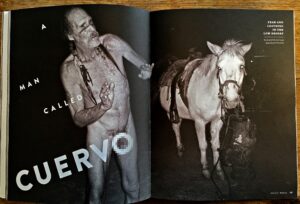
Your philosophy of slow journalism blooms in the chapter, “A Man Called Cuervo.” Photographer Kevin Russ obviously returned multiple times to shadow Craig Kline on the road, in a barbershop and his squatter’s tent. We see Kline in plaid pajama bottoms and electric hair, in dark pants and a knit headscarf, and with long braids and no pants at all. Russ and Collective co-founder Seth Putnam, who wrote the story, undoubtedly devoted many days and nights with this eccentric fellow who commutes via mule “…between Purgatory and hell.” Did photographer Russ’ patience enable him as a confidant to Kline or was the desert nomad so drunk he allowed himself to be photographed nude?
I got a text from Kevin, whom we’ve been close friends with since our first issue, to see if I was interested in a story about a “cowboy living in a mud hut” that he was working on. He had devoted about three months to living with “Cuervo” in order to learn about desert living and mule packing. He met Cuervo a few years back when he was visiting/living in Slab City and took a liking to him, so he decided to come back down and learn as much as he could from him. Cuervo taught him how to purify water, grow food, forage, avoid rattlesnakes and more. He is a very genuine, open and fascinating man, and Kevin certainly became a confidant for him. It’s a testament that if you show genuine interest in another human being, you can open up even the most tightly locked doors.
Kevin is one of the best photojournalists I know. He has the ability to make people feel seen, comfortable, respected and loved without saying a word. It’s his kind soul that even the roughest of folks find soothing and trustworthy. Over the six months we lived in the desert, I visited Kevin and Cuervo every couple of weeks. During those visits, it was incredible to see the relationship they had formed. Kevin had to leave after a while to prepare for a long solo trip to Mexico, which is when Seth arrived on the scene for the story. It was very interesting, after spending so many nights with Cuervo and Kevin, how much different Cuervo became around some of his other acquaintances. There was a notable depression and fragility that was not present when Kevin was there. It was really important for the story to have been able to see both sides of the equation—and to be able to witness how a person can be influenced by others.
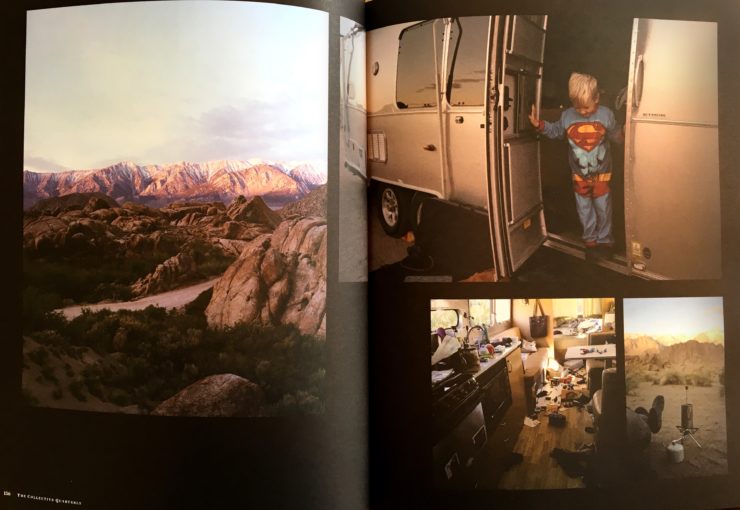
Jesse, your first-person “On The Road” photo essay and story is, as you admit, the antithesis of a “carefully curated” Instagram feed. Your six-month wanderlust in an Airstream trailer took your family to Joshua Tree National Park and the Alabama Hills near Lone Pine, CA. One of the first magazine spreads shows several postcard-perfect compositions of your smooth silver trailer nestled in a desert oasis of massive, wrinkled boulders. Turning the pages gives us your three young towheads playing trucks in the world’s biggest sandbox, bobbing in a hot spring, and crying for mommy amid a skin shredding landscape. Then you reveal the inside of the trailer. I had to laugh, as it’s familiar to any parent: your mobile home is, aaaah, let’s say -- lived in. Jesse, please tell us how doing long-form journalism with three kids in “a tin can” yielded a travelogue that’s like no other.
It was the best of times, and it was the worst of times. Living in a sardine can with a family and a Bull Terrier puppy is tough, and it’s not always thrilling. My kids have slept under redwood trees that have been standing for hundreds of years and parked in front of some of the country’s most stunning vistas. But they’ve also slept in too many Walmart parking lots to count.
Living on the road for almost 1.5 years gave us a really unique look into the feelings of fear, anxiety, isolation felt by many families in lesser-developed or hostile locations. I think those feelings were really important, specifically for this issue, for me to fully realize the duality of the Mojave Desert. When it is just you in a place, you don’t think or worry about things the way you do when your innocent children are in the same (potentially hazardous) situation. When you are far away from civilization and you see small shacks with children’s toys outside, you hear the distant yipping of coyote packs traveling across the descant land and the screams of a heated argument somewhere off in the distance it is impossible not to think: “How can/do you normalize this? How do you not always feel like you have a brick in your stomach?” But then I think back to growing up as the son of missionaries in the former Soviet Union, and I realize that for most of the world, this is normal.
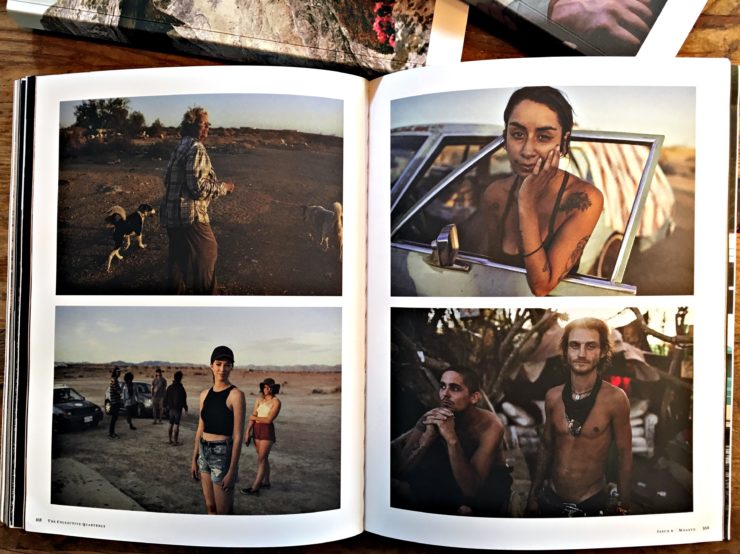
The 12-page spread titled “Slab City – The Last Free Place in America” is written by Genevieve Allison and photographed by Howl Collective. Allison well describes this squatter camp three miles east of the California’s Salton Sea as populated by people yearning to be free – from laws, bills and landlords. She quotes retired nurse Trish Abbott, who settled in Slab City: “because it’s free – and freedom.” As a career- long Southern California photojournalist, I know this self-governing enclave as a visual treasure chest of enigmatic characters. The Howl Collective of photographers obviously fit in, as every beautiful young face we gaze upon appears relaxed in front of the camera. How many photographers were in the Howl Collective? How much time did they spend at Slab City? And tell us why the dozen published photographs are uncaptioned, don’t identify the subjects or say anything about the subject.
I wish I could say that the lack of captions was intentional or a bigger statement about the story, but I can’t. When we started the magazine, we didn’t run a lot of captions except on photos that demanded an explanation—mainly due the seesaw nature of our early content. For example, in our Montana issue, you’re reading about a Blackfoot Indian man named Mouse Hall riding his horse, and then you see of photo of the exact thing just described in the story. In those early days, most of our photography and reporting was done side by side and often had a first-person element to it, with a focus on single characters. However, our last three issues have evolved into more conceptual writing with specific details highlighted by photos and illustration. With that comes a new need to explain what the reader is seeing—but old design habits sometimes die hard and can be glaring in hindsight.
Howl is a group of two photographers (Forest Woodward and Elliot Ross) and two producers (Jim Lind and Patrick O’Brien). They accompanied Genevieve to Slab City for us and spent about a week there. They’re a very talented group of creatives, and it was a great learning experience for us, as it was the first time we assigned a story to such a large group of people.
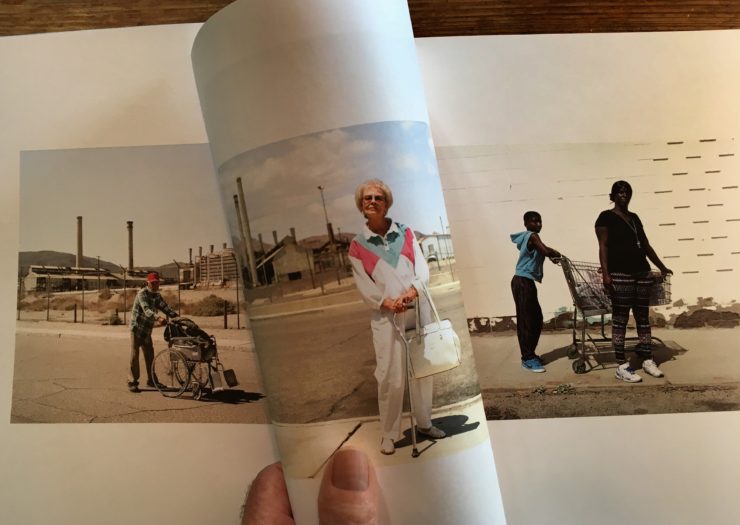
Photographer Ewan Telford’s photo essay “The Autoasphyxiation of Trona, California” opens with a concise essay and a panorama of a chalky white valley where sodium carbonate is sucked from beneath the surface of a prehistoric lake bed. Telford’s shoots the people of Trona like a street photographer – but with permission. They’re stopped dead in their tracks, and most look directly into the camera. What caught your eye about Telford’s work? What do you look for in choosing a photographer for The Collective Quarterly?
I look to see if a photographer has the ability to photograph people in an intimate way. I feel when you look through Instagram, portfolio sites or any other presentations, the one thing that always stands out is when someone has pulled off the difficult task of embedding with a subject so that he or she can capture those intimate moments. Anyone can photograph a sunset in a national park, sexy models or friends in a hot spring. But not everyone can photograph the soul of a stranger.
Ewan’s work was able to bring together environmental photojournalism with a sense of polished high-fashion color photography. This is one of the benefits when you are looking for work created in out-of-the-way places; You don’t find it often, but when you do, it’s usually by the kind of enterprising photographer you hope to work the rest of your life with.
